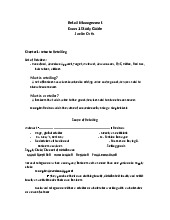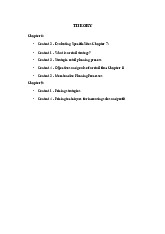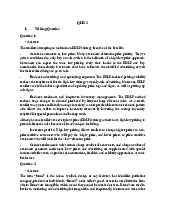



Preview text:
lOMoARcPSD|359 747 69
CHAPTER 13: MERCHANDISE MANAGEMENT I. Questions:
1. Does your favorite clothing store have a private-label brand strategy? If yes, how does it
build store loyalty? If no, how could a private label brand create loyalty?
Answer: GAP produced private-label clothing in 1982. Gap deepens the loyalty of
customers by the new program which is credit-card membership that loyal members can
earn point then redeem rewards. Beside the program, I think that the factor which make
GAP successful is the wide assortment of products, for different age groups. When the
family shopping in center, GAP is also the location that suitable for family shopping
because the products is not only high quality but also various for many people.
2. Why have retailers found exclusive store brands to be an appealing branding option?
Choose a department store, a discount store, and a grocery store. What exclusive
privatelabel brands do they offer? How are they positioned in relation to their national brand counterparts?
Answers: These are some advantages that stores band have:
1/ With the same quality of products, store brands may cheaper than manufacturer brand.
2/ Most of the items that store brands sold is base on the demand of consumers, clear target market.
3/Merchandise mix is the strength of store brands.
Generally, the department store in VN like Big C have some products which have
exclusive private-label brands like food some necessary in daily life (non-food items).
There is various merchandise for people. Discount stores like E-mart have both non-food
and food products with the cheaper cost. Grocery stores like have a limited merchandise, typically food and beverage.
In my opinion, the appearance of private-label brands will be against the national brands.
Pricing is one of the main elements that most consumers consider. As a result, people
who are in middle and lower class in society tend to buy merchandise at department
store, grocery store,… National brands still maintain their position in market but not
everyone can afford with the expensive items. So, those mentioned stores can be big competitor to national brand.
3. What are retailers doing to be more socially responsible in buying merchandise? Why are
they becoming more socially responsible? Do you buy products that you believe were
produced in a socially responsible manner, even if they cost more?
To be more socially responsible in buying merchandise: 1/ Ecofriendly campaign. lOMoARcPSD|359 747 69
The Body Shop often host some event like take back the empty glass bottles to recycle.
Some retailers in Vietnam start to use paper package instead of plastic
Uniqlo shares that they optimize the amount of water in jean production compare with other brands. 2/ Charity campaign
Sendo has promoted to help local farmers with consuming agricultural products in COVID-19 pandemic.
In my opinion, people awareness is risen with the development of technology, and they
tend to concern about environmental issues, climate change, charity and donation,… In the past
few years, consumers just buy merchandise to meet their demand but nowadays, people
especially young adults not only buy products but also concern the meaning behind the products,
they tend to buy the products of which brand have the socially responsibility because they realize
the consequence that manufacturing bring to the Earth.
Obviously, I prefer to buy merchandise produced in a socially responsible manner because
not only good quality production but also help improve poverty, climate change. The products
maybe more expensive than other brands but if that money use for the good purpose, they are worthy buying. II. Exercises:
A convenience store is considering about the investment into the list of SKUs as following:
Annual sale Average Inventory Inventory GMROI SKUs ($) at cost ($) Gross Margin (%) Turnover 1 420000 210000 24 2 170000 51000 28 3 190000 19000 14 4 150000 30000 30 5 120000 24000 44 6 190000 38000 43 7 190000 57000 37 8 120000 12000 25 9 150000 30000 50 10 160000 80000 17 11 150000 75000 33 12 170000 51000 16 13 180000 36000 44 14 120000 36000 27 15 170000 17000 11 lOMoARcPSD|359 747 69
a. Base on annual sale, applying ABC analysis identifies the performance of individual
SKUs in the assortment plan. The raking scale is used as the studied example. Determine
about what product should never be out of stock.
First, I calculate the %value by divide the annual sales of one SKU to sum of annual sale
then multiply by 100. Next, I’m going to sort the data by %value from the highest to the
lowest one. The class A items have more than 70% value, the class B items is about
15% value and the class C is less than 10% value In conclusion, we have this table:
Table 1 Invventory turnover, GMROI and classification of SKUs
=> The class A SKU (1; 3; 6; 7; 13; 2; 12; 15; 10; 4) never stock out.
b. What is the GMROI & inventory turnover for each merchandise categories? (Table 1 above at question a)
c. From question a and b, determine the list of SKUs need to invest. why?
We need to invest the SKUs both have the high value of GMROI and belong to class A. GMROI
measures the efficiency with which retail operation transforms inventory into gross profit. As a
result, the higher GMROI the more profit that company have. When the GMROI ≥ 1, which
mean earning revenue higher than 100% of cost. Moreover, the class A items is the products
bring more value than other class. So, we consider SKUs 3; 6; 7; 13 and 15. However, the
inventory turnover is the important impact that we should notice. Observing the table 1 above, lOMoARcPSD|359 747 69
the value of inventory turnover of SKUs 3 and 15 is high but the GMROI is small, which mean
that these products are at risk of stockout but the profit is low. It is risky if we invest in SKUs 3 and 15.


